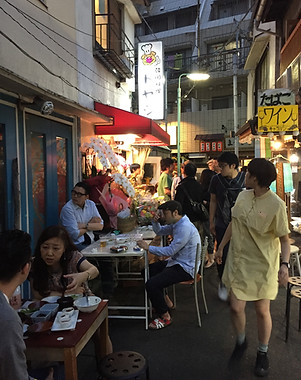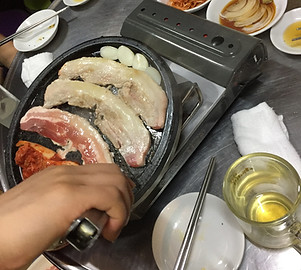A Taste of Cheju Island from an Immigrant Mother
On June 3rd and 4th this year the small Korean restaurant Toyaji held a tenth anniversary celebration that spilled out into Willow Alley, in front of the restaurant. Flowers and pig-shaped balloons decorated the storefront. As soon as the shop opened, regular customers dropped in, congratulating the owner. Many brought flowers or gifts. One couple with a small child presented flowers and took a picture with the owner and her daughter. Overhearing their conversation, it seems they became regulars here before the child was born. In addition to the first and second floor indoor dining areas, an extra table put out in the alley filled up quickly. Two men came together. One was an amateur boxer living in Nishiogi who had been coming to the restaurant for nine years. Another was a Korean friend who was now looking for a place to live in Nishiogi. He said “congratulations” to the owner’s daughter in Korean. Today beer and makgeolli were all just 100 yen a cup. People drank and waited for a taste of “Mom’s cooking.” As the Korean visitor savored his stewed mackerel and grilled pork skewers, he said with satisfaction, “This tastes like the food my grandmother made on Cheju.”
Toyaji is run by Ms. Yoshida Nanami, who was born in Cheju, and her daughter Yoshida Yonju, who grew up in both Japan and Korea, and attended university in Japan. The name “Toyaji” is Cheju dialect for pig. And grilled pork is the specialty of the house. The T-shirts of Ms. Yoshida and her staff are emblazoned with a colorful pig logo.
The mother Yoshida explained to us how she came to have such a group of loyal customers. She came to Japan twenty-three years earlier because of her marriage, then worked in an office for nearly fifteen years. She and her colleagues would frequently dine at the Korean restaurants near her workplace in Shinjuku. She had long felt tempted to open a restaurant herself, she said, but it was not easy to quit her company job. “My daughter said, ‘Mom, if you want to open a restaurant just do it.’”
Finally, because she felt her health was failing from working at the office job, she decided to try her hand at running a restaurant, where she could work at her own pace. Perhaps only in Japan would restaurant work ever be imagined to be a respite from the long hours of office work. She also could rely upon her daughter. “At the time my daughter was a second-year university student. So, I thought that while she is going to university, she will be able to help out. I thought I would not be able to do it by myself. But my daughter said, ‘I will support you! Just do it!’ So, I started looking for a place.”
In terms of the long hours, the restaurant wasn’t much of an improvement over office work, but it did gain her autonomy. She still relies upon her daughter to co-manage the restaurant, as well as student workers to fill in as servers.
Mother Yoshida was living in Gotanda and working in Shinjuku, so it was a bit of a coincidence that she ended up all the way out in Nishiogi. “There were two Korean brothers who were doing a yakiniku business at this space, and when they quit, I heard about it and came out. They had been closed about a month. It was my first time out in Nishiogi.”
She had no connection to the two brothers, but the place fitted her. “It wasn’t so big, so it wasn’t so scary a prospect to start out here,” she said. The previous tenants were just using the first floor. She decided to put some tables up on the second floor as well. Altogether the first and second floors can seat forty customers and another ten can sit at the table outside.
The ability to put tables out on the street is a distinguishing feature of Willow Alley. We asked her how this is possible. “This is a private alley, so no one really minds. We just check with the people across the alley, and make sure that it is possible for people to pass through. This alleyway is administered by a private real estate company, not by the government, so it is okay to put tables outside. As long as we can work it out with the neighboring shops, we can even put out several.”
As for the menu, “It hasn’t changed much in ten years,” Yoshida said. The most popular item is still the samgyeopsal, Korean-style pork belly. “Most of the customers come here looking for the samgyeopsal.”
“Other than the pork belly, it is mostly side dishes,” Yoshida said. “Yakiniku is bothersome. Most people come here to drink. They order side dishes. Especially in the summer, they order a beer and some side dish with meat like bossam, or something like bulgogi, things made in the kitchen.”
Various types of customers stop by during different times of the day. In the early hours people may just come to eat, later they may come only for the drinking. Yoshida explained, “In the early hours many people bring children, or salarymen may come. Then there are the female college students, probably walking over from the nearby Tokyo Women’s University. Sometimes you look inside and it is all girls. There’s not a male in sight!”
“Girls will say, ‘I got up my courage up and came inside.’ If they come in once, then the next time it is okay. Because both of us working here are women they will think it is safe to come in. And there are many women who will come in and eat alone. Many people live around here, and after work they will come here, have a drink to relax, eat dinner and go home. There are even people, women alone, who will eat yakiniku by themselves!”
As for the recipes, she has learned quite a few of them from a friend in Korea who also runs a restaurant. “The friend would invite people over to eat at her house, and also come to my house…. So, the dishes we have now are a balance of these experiences. So, I studied with this Korean friend. I go over there three or four times a year. This person is actually quite famous. Sometimes there are things I will forget. I will call up on the phone and ask. And she will say ‘put this in here.’ Or ‘that requires that to taste good.’ Housewives are the same way. It’s like ‘This! Add this ingredient in, and it is just right!’ It is that kind of process.”
The general theme is home-style Korean cooking. According to the mother Yoshida, all of the dishes are handmade except for the Korean stuffed intestine sausages called soondae. “We buy the meat from a Korean butcher here, and we can ask them to cut it to the right thickness. Korean yakiniku is different from Japanese yakiniku. I have never used Japanese yakiniku meat, but it is different. The way they prepare it is different. The meat we buy is really delicious.”
Yoshida has seen a lot of change in Willow Alley. “The place was so lively when we came in,” she said. “So, we decided to take the location immediately. It was the right size too. It was not so big. But even more important was the atmosphere. It was like the kind of old Japanese atmosphere you see on television. It was like the postwar Showa era. Now, well, it’s a bit different. In the last three or four years, nearly all of the old ‘snack bars’ have closed down. And the atmosphere is not like the old one. There is more of a feeling of rejuvenation in the neighborhood, brighter and newer. These are still drinking places but a little stylish.”
The old ‘mama-san’ of the snack bars still are part of the scene, she said. “They drop by. Yoshiko-san who used to run the bar where the ‘Caravan’ is now, she came around to drink yesterday. She is the most senior one. She ran the bar there for over thirty years, and it was the oldest in the neighborhood. The women who worked as mama-san at the snack bars are all very lively. They all live around here, so they come around to drink.”
As we could see at the tenth anniversary, the mother-daughter team now have close ties with the customers at Toyaji. The younger Yoshida explained, “Of course, the environment is changing, but many of the ones who came here in the beginning are still connected. Some people have gone overseas, but they all still stay in touch. It’s been a pretty long time already. Many people have gone back to their home towns, but when they come to Nishiogi, they will drop by. And those young people who come from the countryside, when their mother comes to visit, they will bring her by. When I was here working for my mother, they dropped by. They brought their mother over and introduced her. I was really happy.”
As the mother and daughter told us, some of the regular customers have even joined them on their staff trips.
Toyaji also participates in the “daytime market” that was originally organized by the owners of the Thai restaurant Handsome. This event occurs on the third Sunday of every month. At first, only Handsome was doing it, Yoshida said. But she asked if she too could take part in it, and the owners of Handsome replied that it was entirely her own choice. “Since then I have been participating every month,” she said, “rain or shine.” Now most of the shops on the street are participating, she said, and many find that the day is so busy they are dead tired at night.
Indeed, the event has attracted so many customers that some of the older snack bars have complained about the already drunken customers still lingering around in the late Sunday afternoon. Some of the managers have suggested that they try to shut down the midday market by three, to clear the street. Some of the older “mama-san” will complain to the management at Handsome, Yoshida explained, and the guys there end up with the headache of managing this friction. Overall, however, together running this daytime market has increased the cooperation among the shops on the street.
Starting out as a nervous immigrant entrepreneur with no restaurant experience, Yoshida and her daughter came to this narrow alleyway with no social connections or local knowledge. A decade later, they are now getting along well with the other shop owners and also have built a very close community of regular customers (James Farrer, July 7, 2017).
(English text by James Farrer; interview by James Farrer and Fumiko Kimura; Japanese transcription and editing by Fumiko Kimura; translation by James Farrer; copyright James Farrer 2017)









